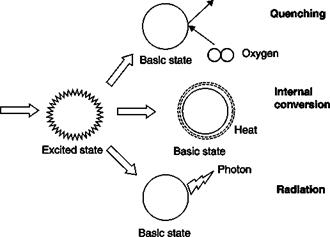Pressure-sensitive paints
Pressure-sensitive paints (PSP) have been used since 1980 to display and measure the distribution of pressures throughout the model. The advantages of the method are:
■ continuous pressure measurements on the whole surface;
■ non-intrusiveness, since there are no probes to be introduced in the fluid flow;
■ reduced time and cost of preparing the model (there are no orifices to be made, transducers or pressure tubes or scanning valves to be inserted in the model);
■ high resolution, limited only by the size of the pixels of the camera system.
Disadvantages are:
■ sensitivity to temperature;
■ the need for prior calibration;
■ filming techniques and sophisticated data processing.
The paints are made of luminescent substances, embedded in a binder, that, when excited by light radiation (UV or visible light), re-emit (Figure 1.13) part of it as light with a different wavelength (fluorescence), transforms a part of it in internal energy (internal conversion), and a part of the energy goes to excite oxygen molecules (oxygen quenching).
Re-emission of a luminescent molecule
 Activated oxygen
Activated oxygen
oo
![]()
 Photon
Photon
Since the luminescence is reduced by the presence of oxygen molecules, increasing pressure, and thus the partial pressure of oxygen, tends to mitigate the intensity of the light emitted: a measure of the distribution of the latter on the surface of the model therefore allows the distribution of pressure to be traced.














